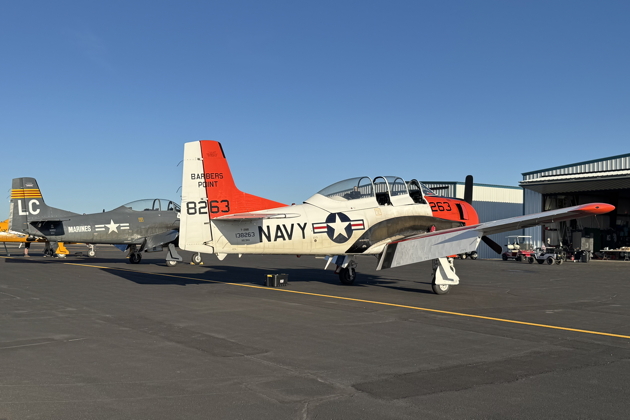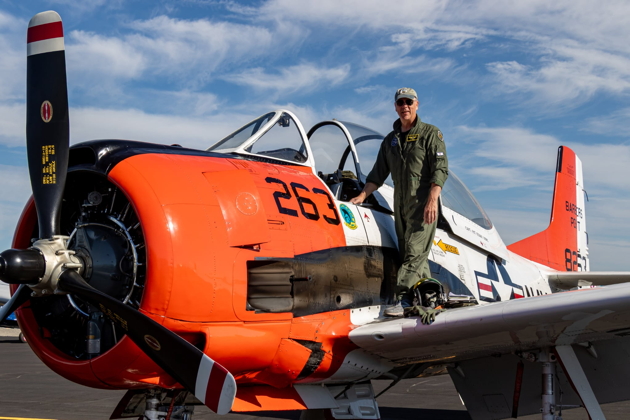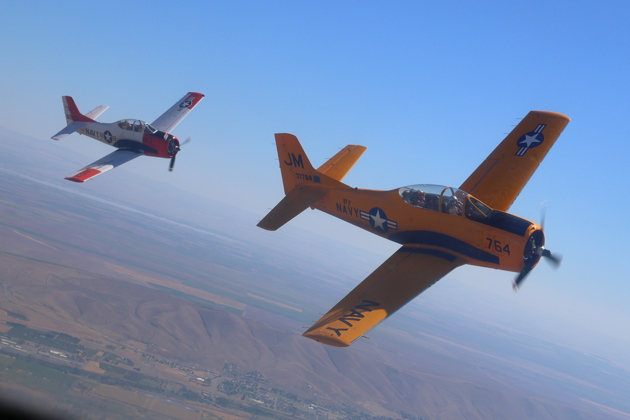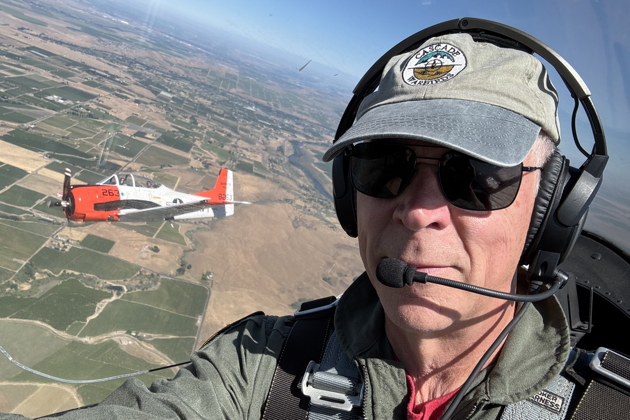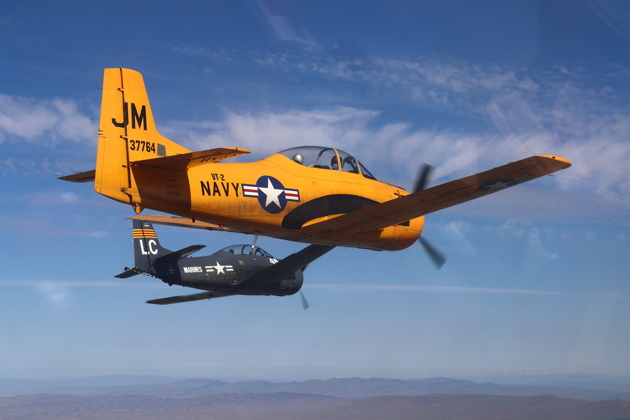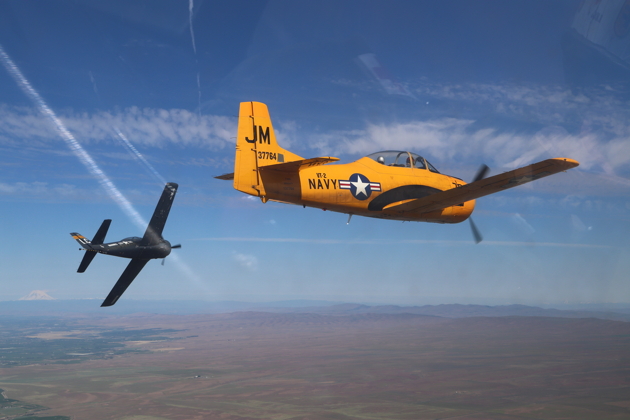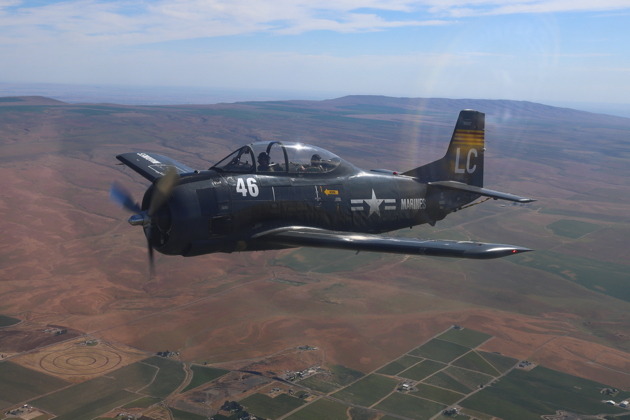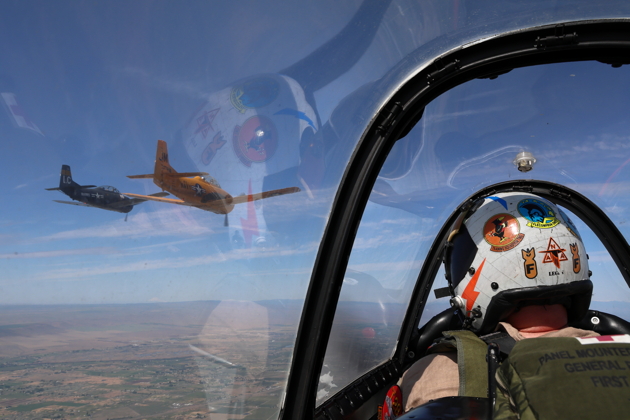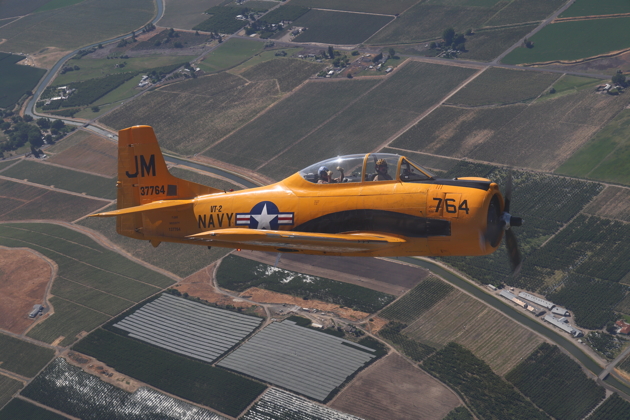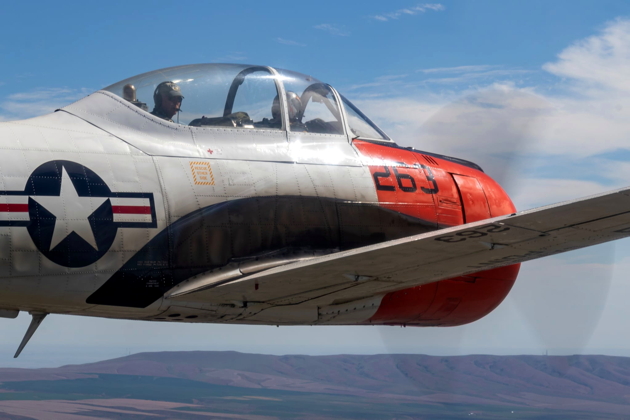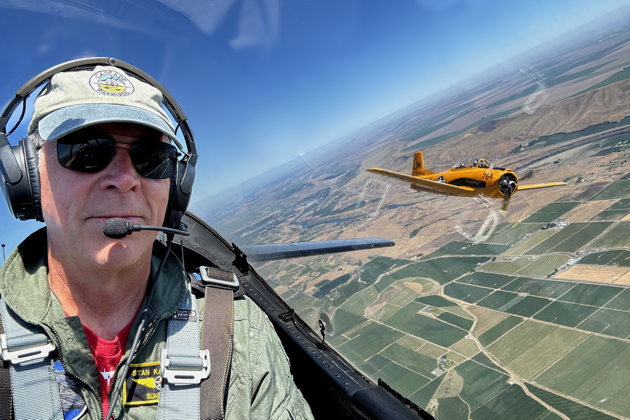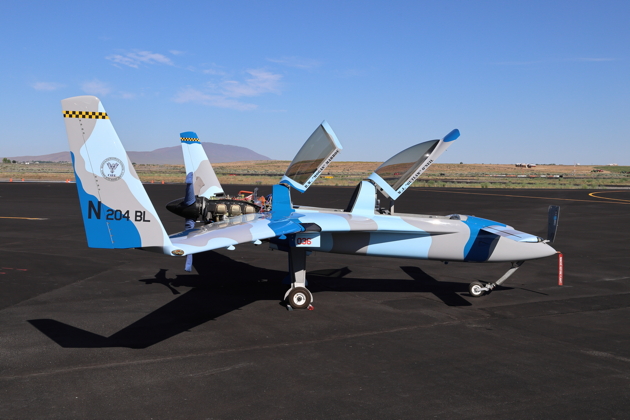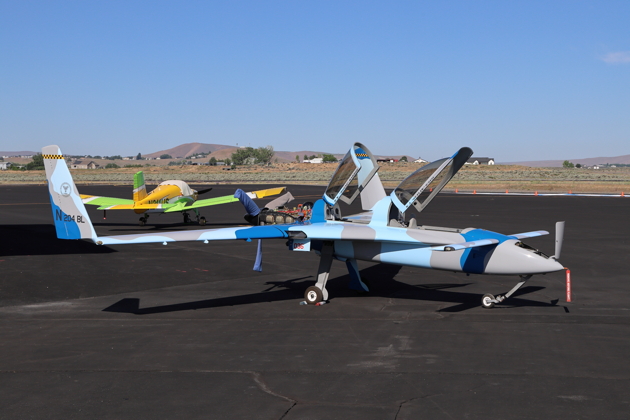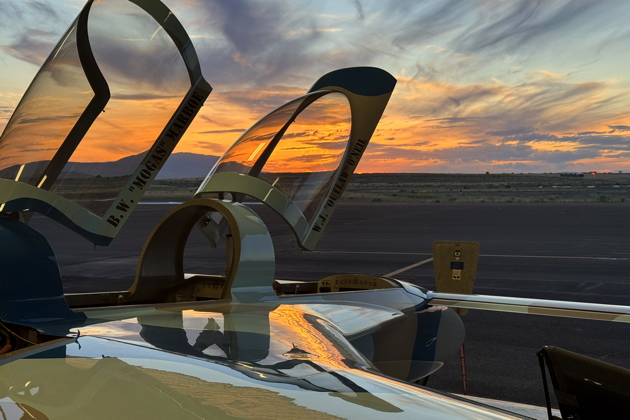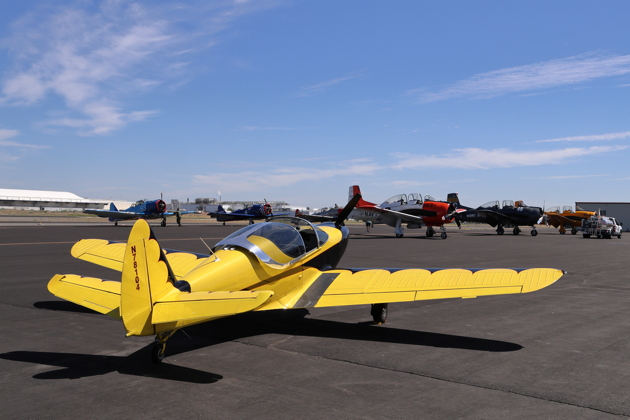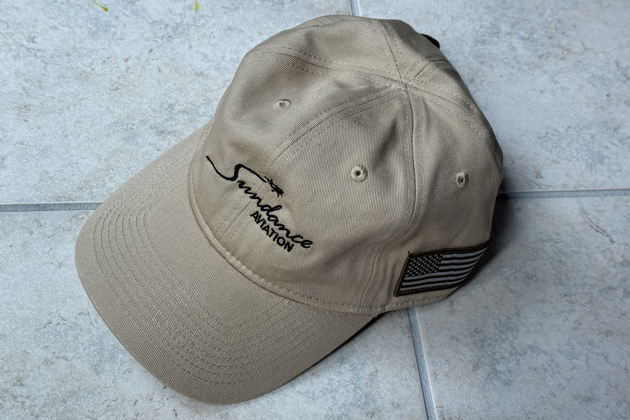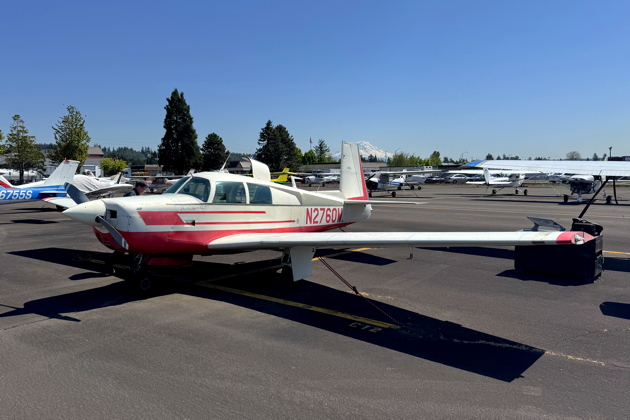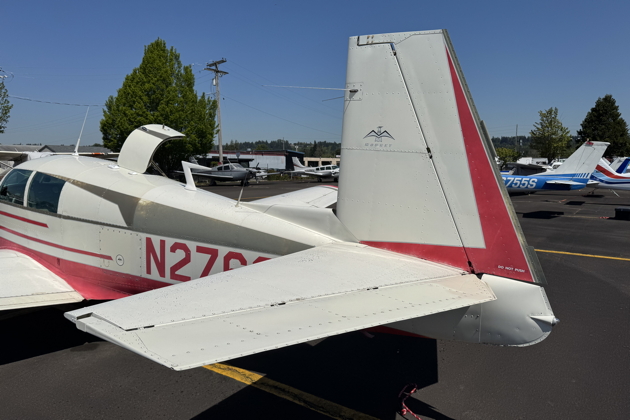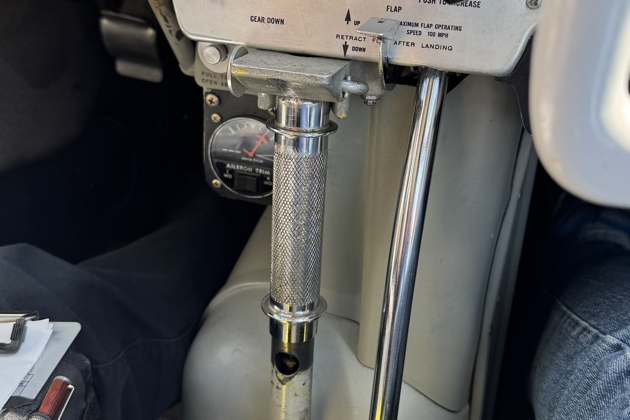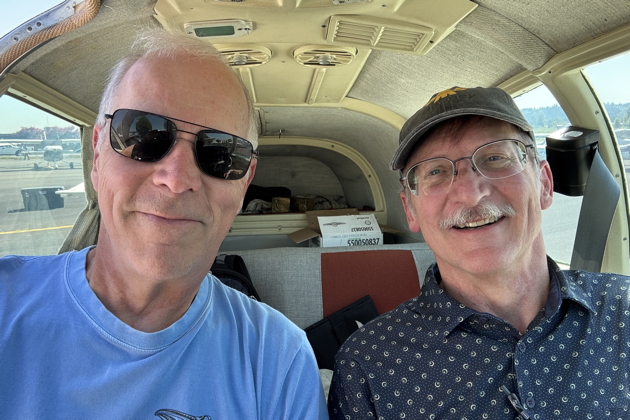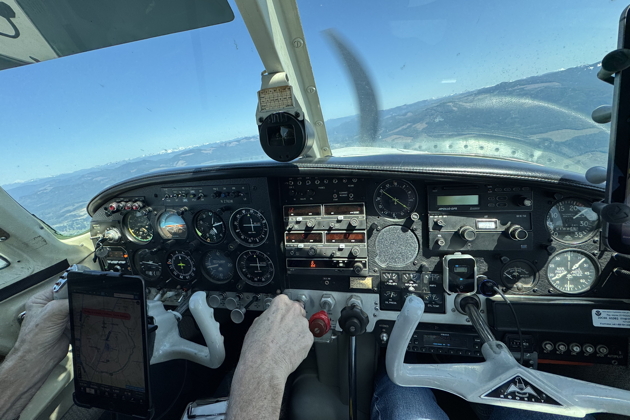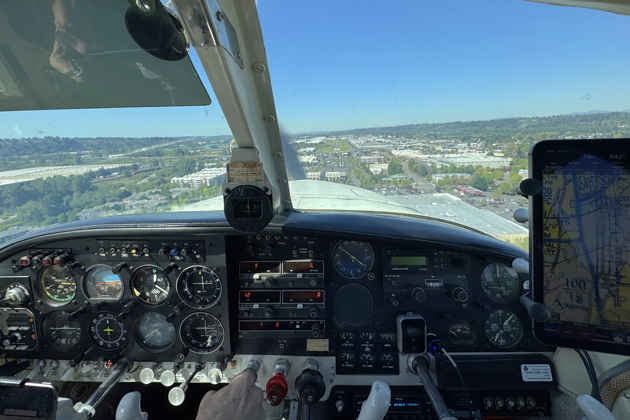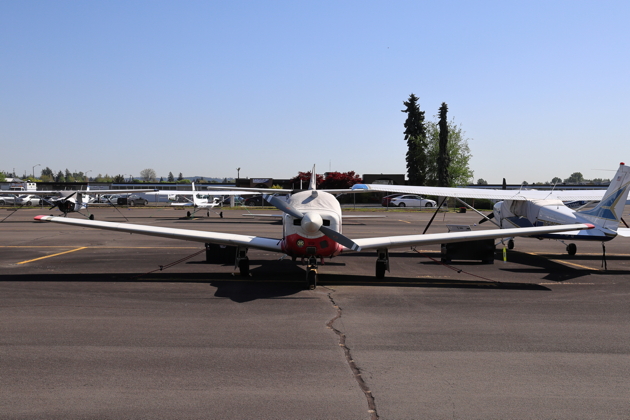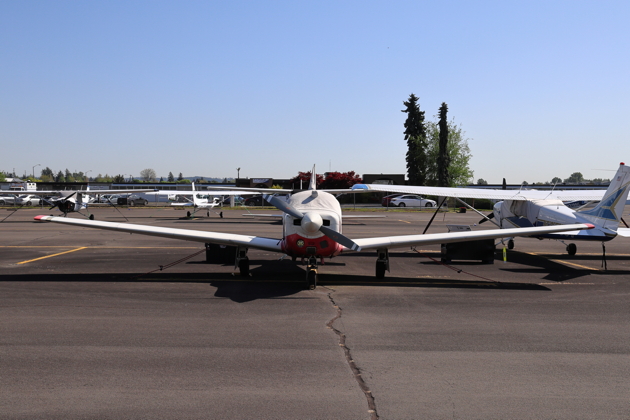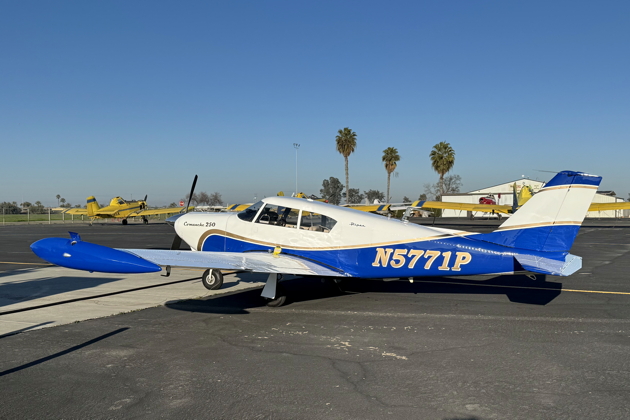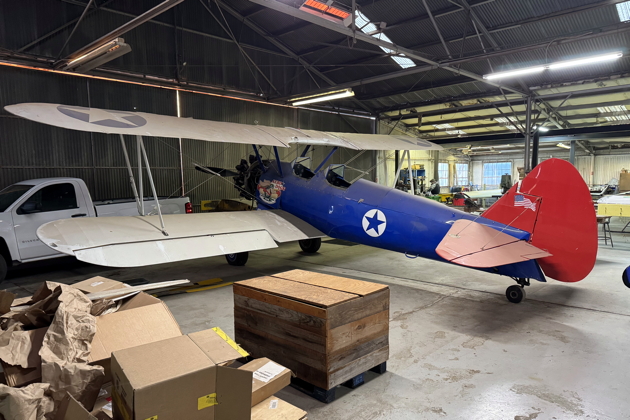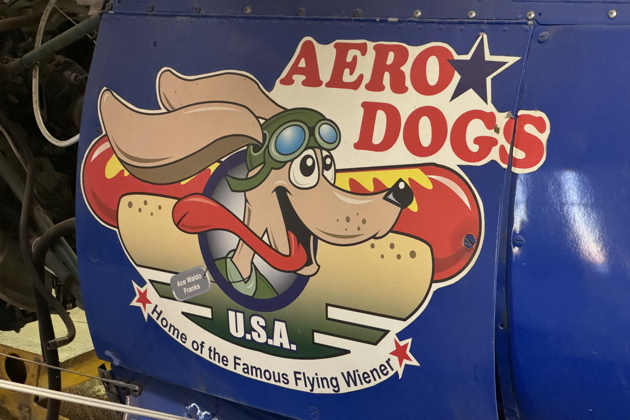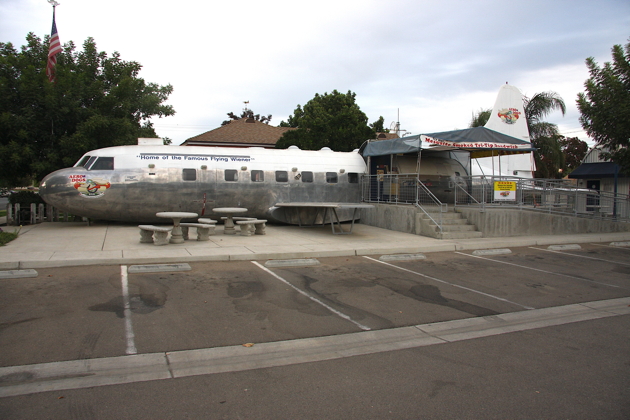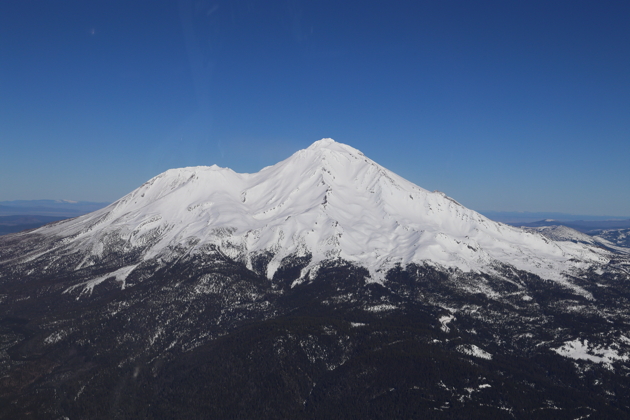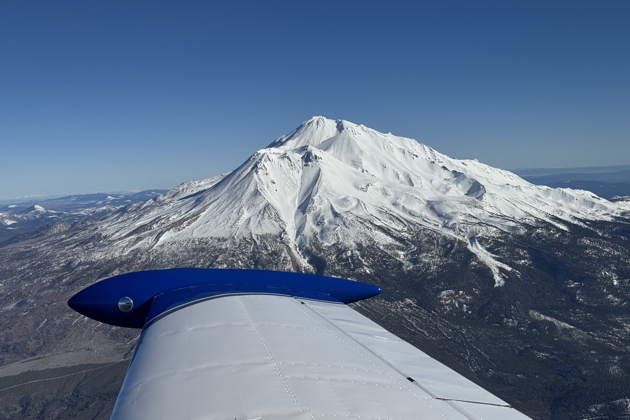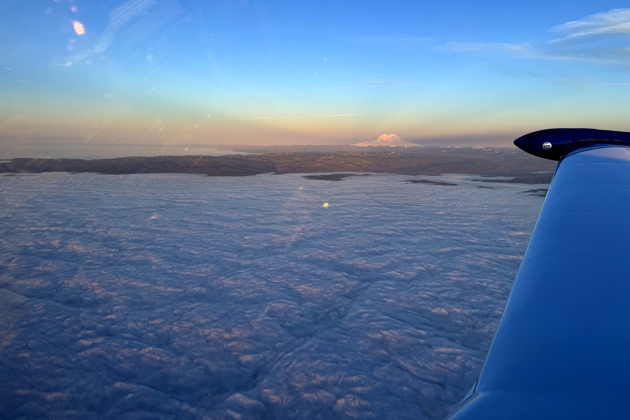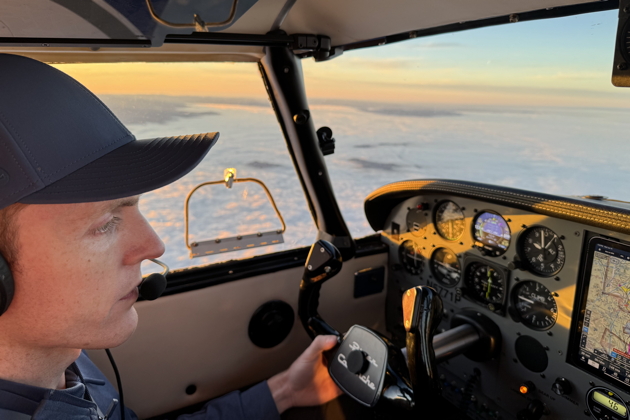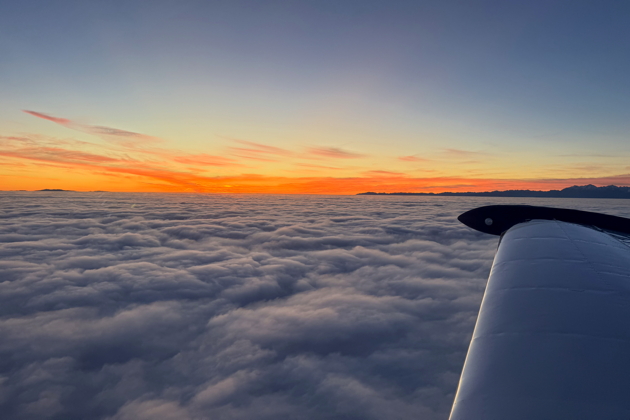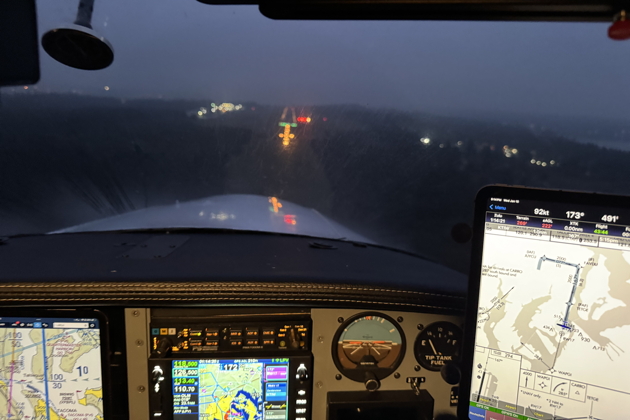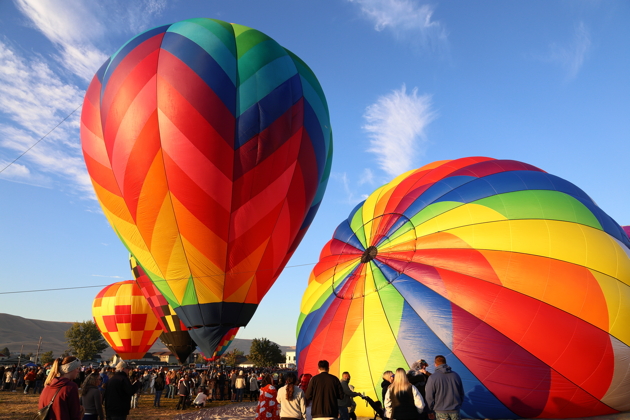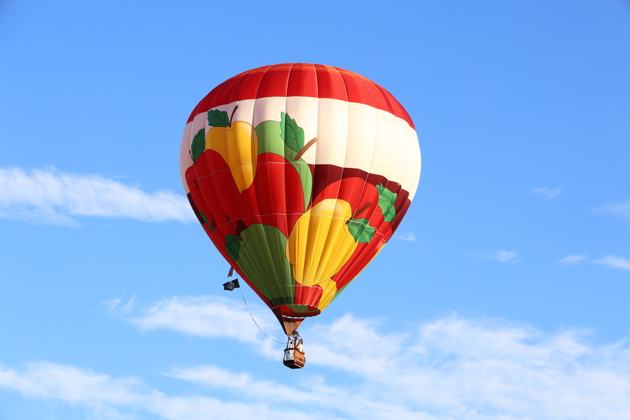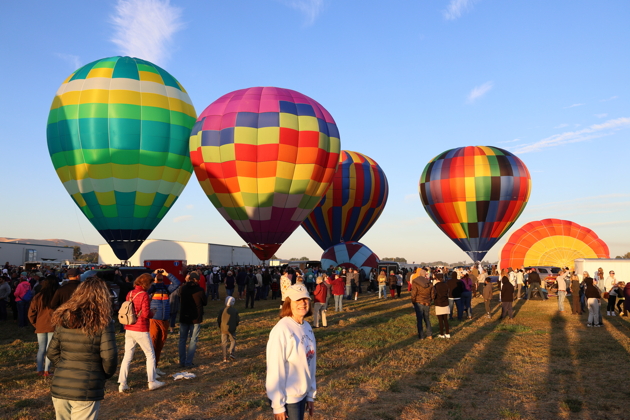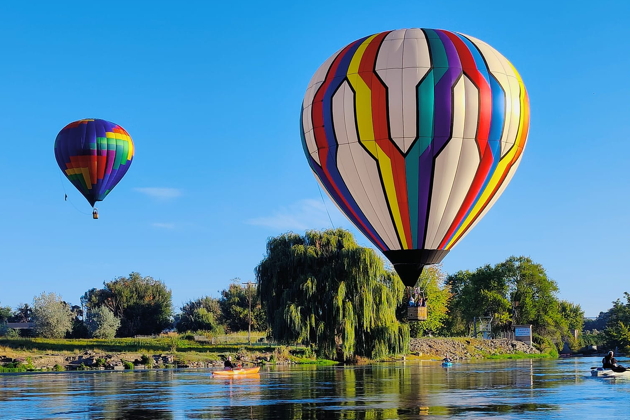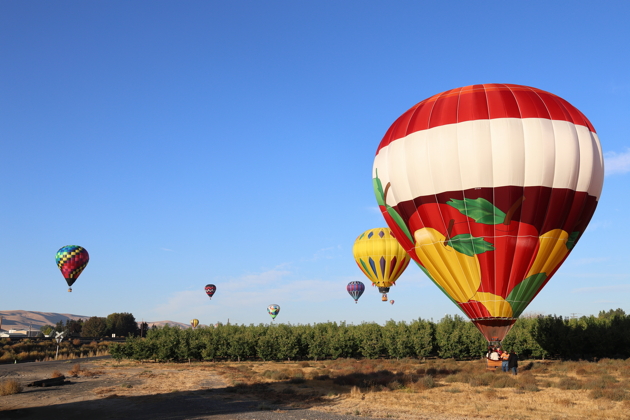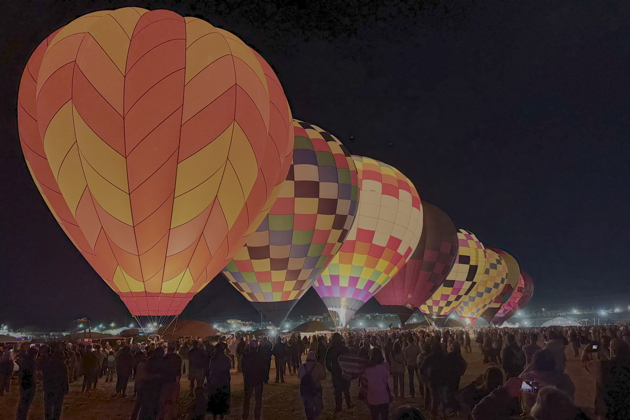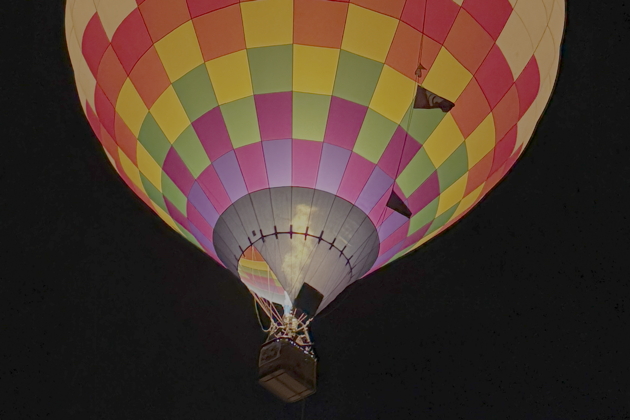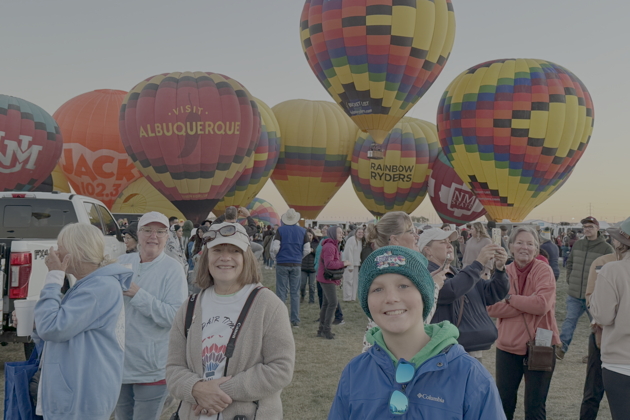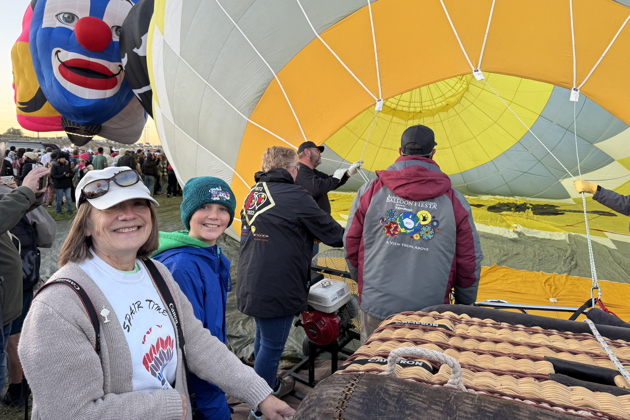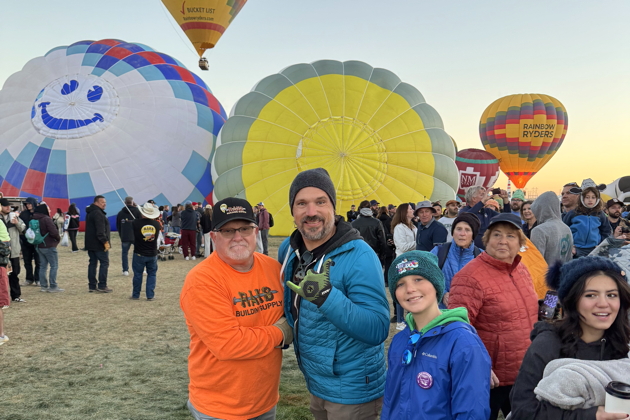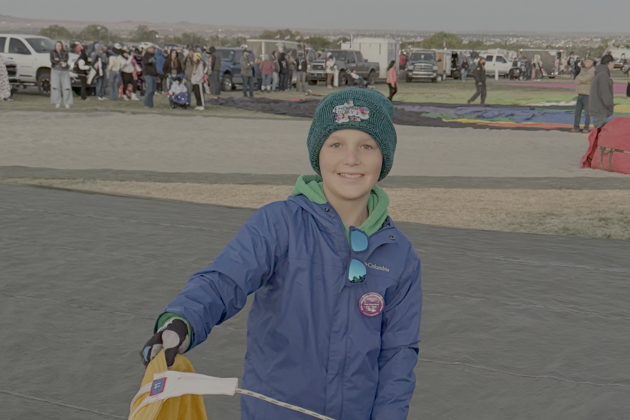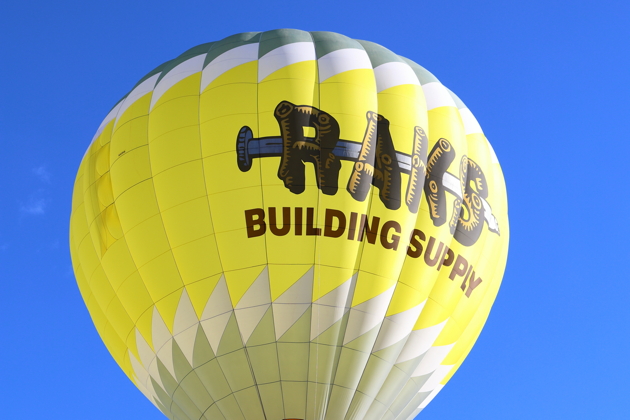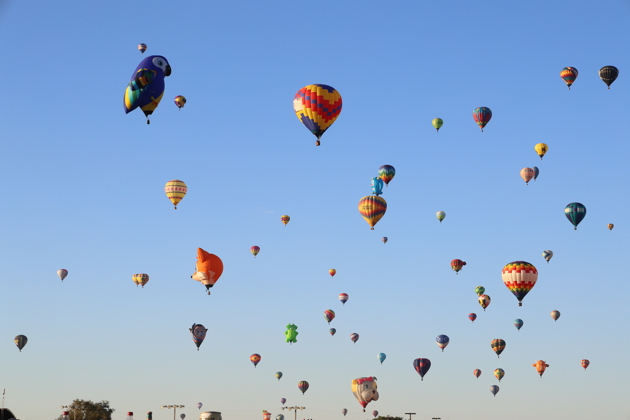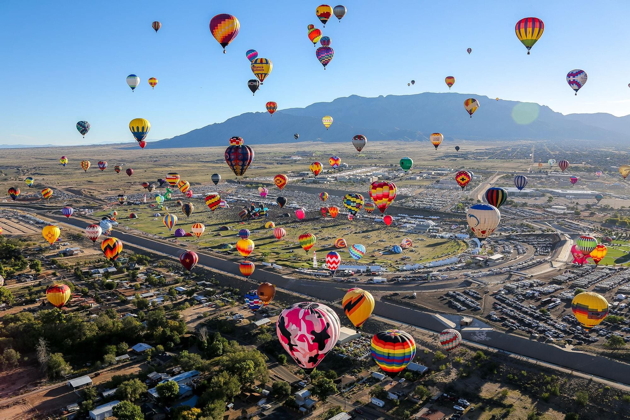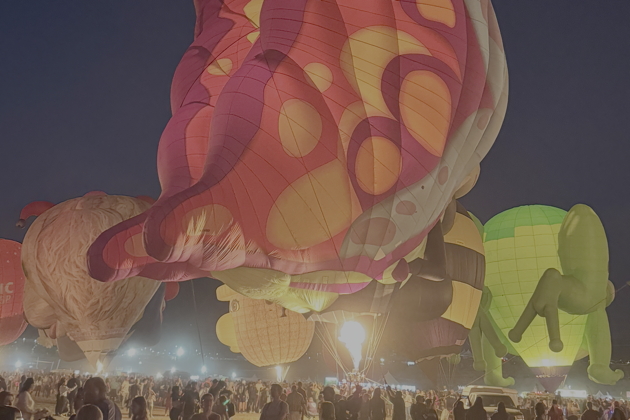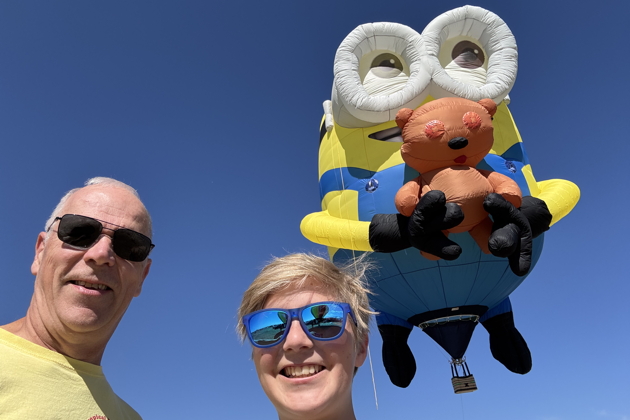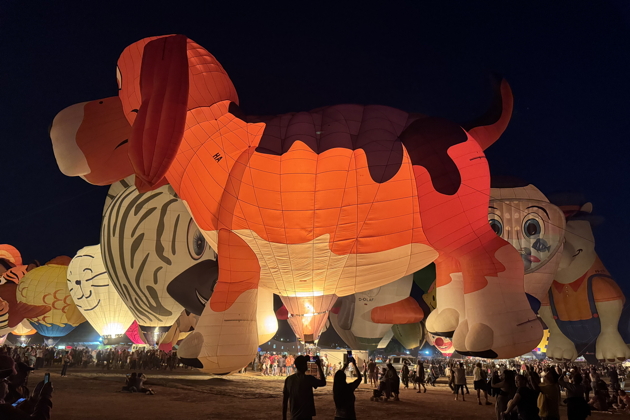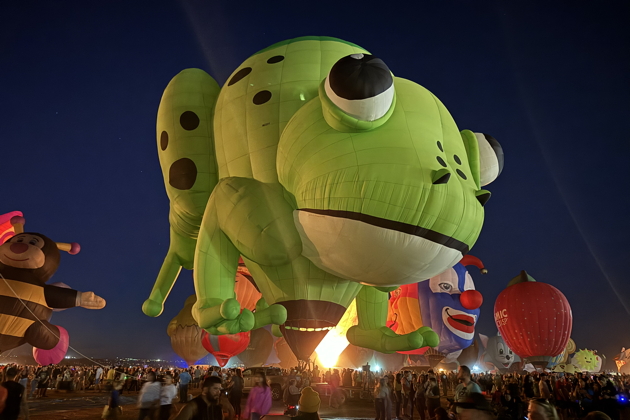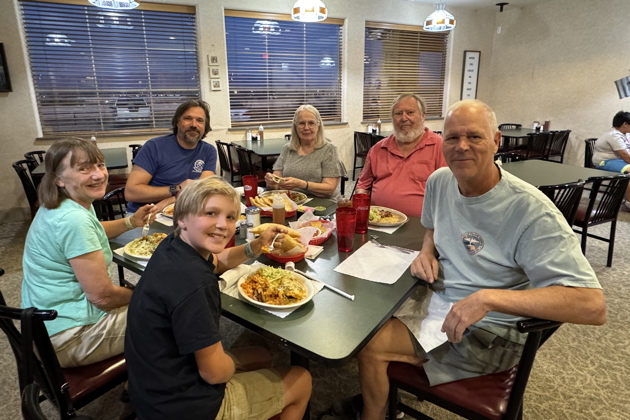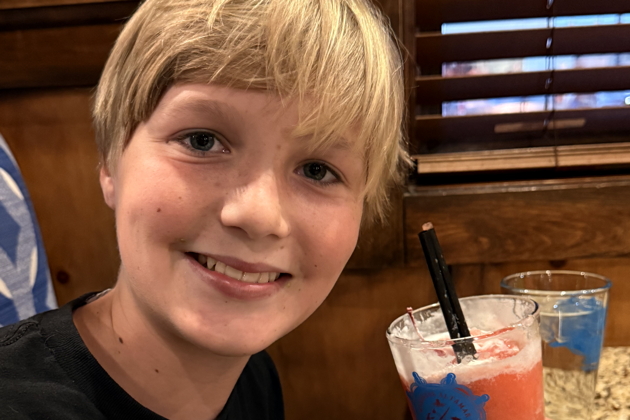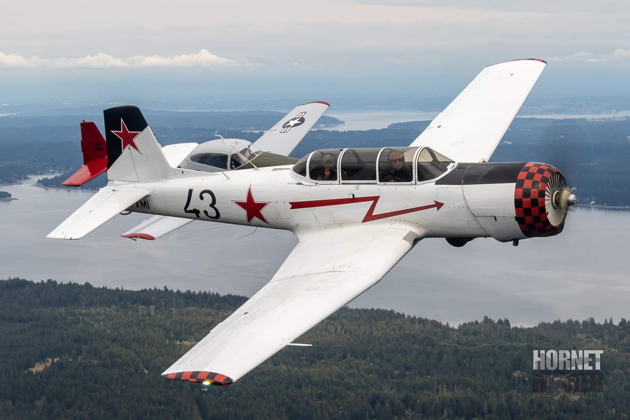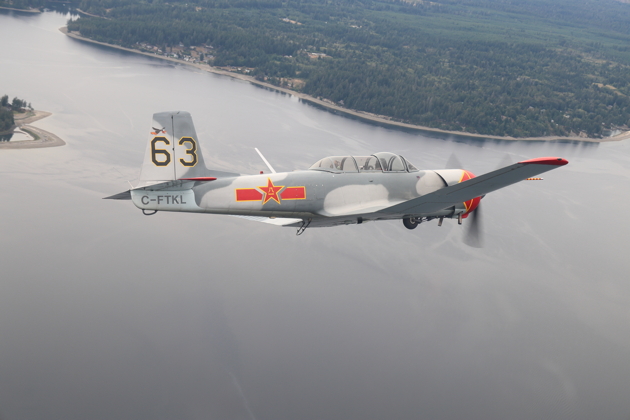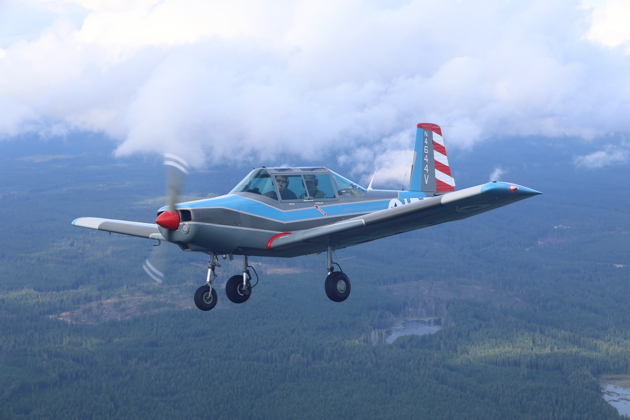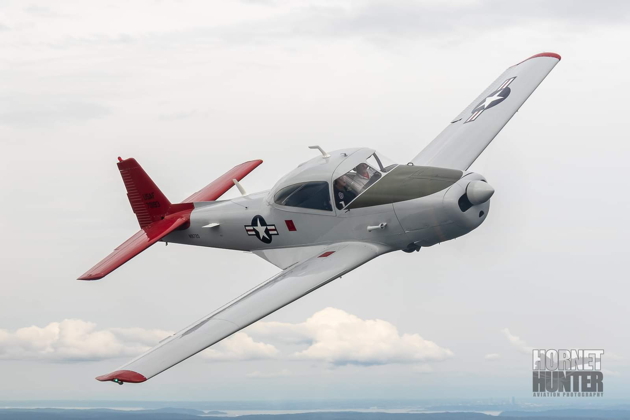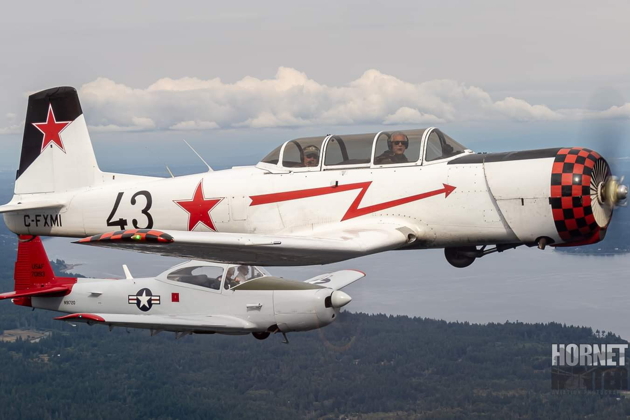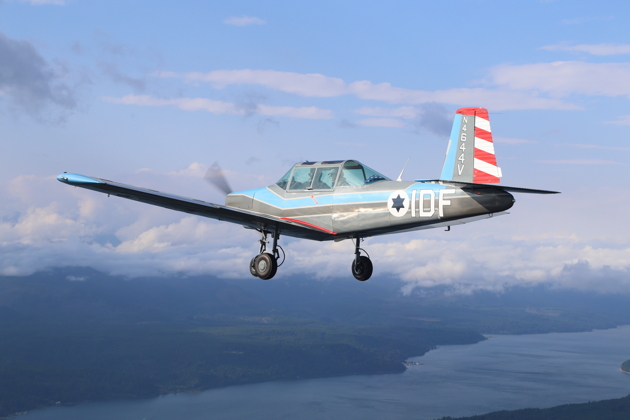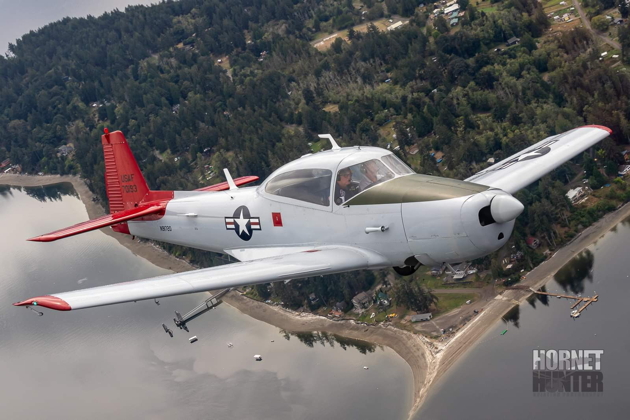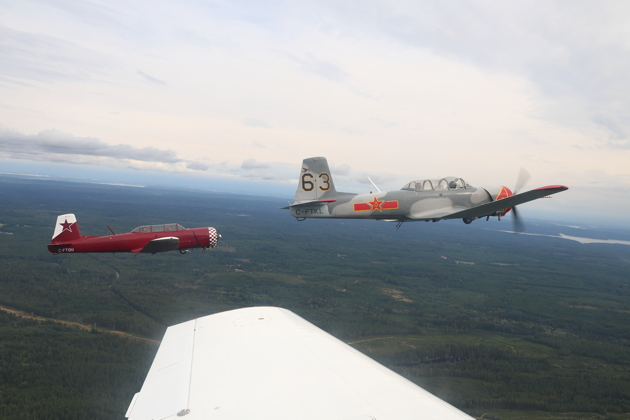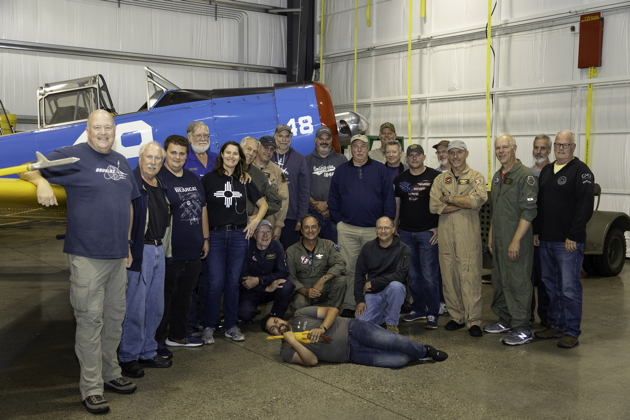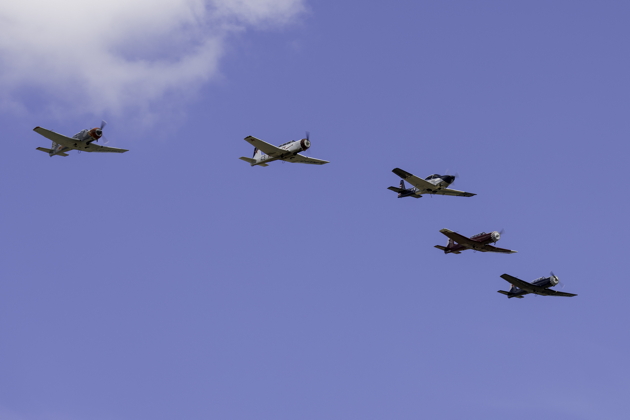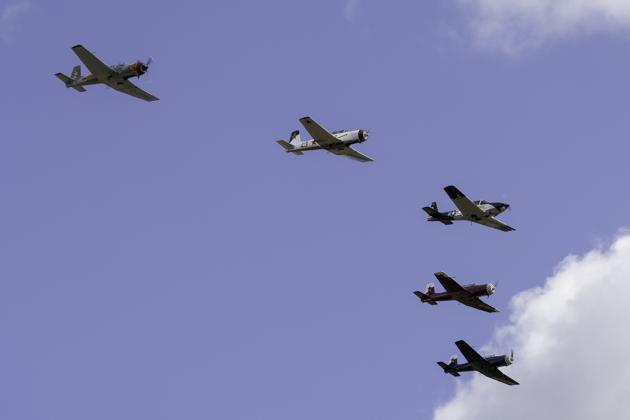FlightLog Archive
∟Aircraft Flown
Richland T-28s - May 2025
I've enjoyed the unique opportunity to fly a number of formation training flights recently in the powerful T-28 Trojan. Years ago I took an extensive ground school course by T-28 instructor Michael Kopp, and had flown training flights in his former T-28B when it was acquired by Scott Urban.
In early 2025, Scott contacted me about supporting an informal formation clinic that he was hosting at his home field of Richland, WA (KRLD). We had three T-28s and four T-6s arrive by Friday morning for the clinic, with gorgeous early summer-like weather forecast. I presented a safety briefing to help set the tone, and we also received a parachute orientation in the evening, while enjoying smash burger tortillas for dinner at Scott's hangar.
Friday started with our first 'get the rust out' T-28 three-ship, with Roger Collins leading in his T-28C, Charlie Goldbach flying his T-28B with me in the backseat, and Scott Urban flying as #3 in his T-28B. The weather was perfect, clear and low 80s, and our working area was close by, over the Sunnyside airfield. We all had a little rust to work off, especially in comm and rejoins, but everyone took it slow for a safe and smooth flight.
Scott had arranged for all the participating pilots to join for lunch at Ann's Best Creole, nearby at the airport. Everyone was impressed with the large lunch portions, and I enjoyed a delicious catfish Po Boy. Next to the restaurant was the Fixed Base Operator (FBO), Sundance Aviation. I stopped by to meet the owner, Clif Dyer, while wearing my Sundance name tag and sporting my Sundance hat. Clif showed me around, and presented me with a complimentary Sundance Aviation ball cap.
We briefed and I flew a second flight in Roger Collins' T-28C N28LC, with Pete Blood as #2 with John Muszala in his pit, and Scott Urban as #3 with Jeff Hanoff, Richland CAF PT-23 driver, in his pit. We climbed again to the area over Sunnyside, practicing close formation, echelon turns and many rejoins, then flew as a wingman when Scott Urban took the lead. We smoked back to the bumpy overhead pattern at 200 knots, and enjoyed a spaghetti dinner while debriefing. Scott's wife Desiree mixed up two Purple Fox drinks, with Empress gin, tonic water, lime juice and a bit of maraschino cherry juice, for my first enjoyable gin drink in 50 years.
I also was able to check out a number of other impressive aircraft in nearby hangars, including Bill O'Neil's amazing camouflaged Berkut and a pristine yellow Swift owned by George Stanley.
On Saturday, I instructed in my third T-28 flight, with better three-ship comm and less rust evident in most of the maneuvering, still with some difficulty in rejoins, prompting a few overshoots, but everyone felt much smoother and relaxed after the three good workout formation flights.
Thanks for the invite, Scott, and the enjoyable opportunity to fly in your gorgeous T-28, along with Charlie and Roger's awesome birds! Sign me up for Richland 2026!
Mooney Time - May 2025
Many years ago, I was sitting F-15 alert at two different locations - Minot, ND and Holloman AFB in Alamogordo, NM. We swapped out three pilots a week to and from Holloman, initially using our two-seat F-15Bs, then using airline flights to complete the weekly swap out. I looked for a way to complete the swap by using a private rented aircraft, both to get some flying time for our pilots, and also to avoid airline 'cattle car' passenger flying. I worked out a checkout program with the Fixed Based Operator at the Minot civilian airport, who suggested a Mooney would work well for our weekly cross-country, since it was fairly fast and relatively inexpensive to rent for the weekly missions. I let one of the other squadron pilots get the first Mooney checkout, while riding along in the backseat, getting ready for my turn in the left seat. Unfortunately, higher headquarters decided to cancel the program just as I was to start my checkout flight. No Mooney pilot-in-command time back then!
Recently, my friend and Cessna 150 owner Chris, who I had been providing instrument training, decided he needed a more capable cross-country and passenger-carrying option than the venerable Cessna 150. After a lot of aircraft evaluations, he found a Mooney that was available and fit his mission, and asked if I could help get him checked out. Although I have flown over 100 different aircraft types, the Mooney had eluded me. With over 11,000 total Mooneys produced, I felt it wouldn't be hard to find another local Mooney for an initial checkout. I was pleasantly surprised, while parking my Warrior after a flight at my Auburn, WA home base, to find out that Bob was the owner of the M20E parked adjacent to my aircraft at Auburn, and he graciously offered me some time in his bird. Aviation is definitely a small, interlinked, generous community.
Over 11,000 Mooney M20 aircraft in total have been produced across three production runs, starting in 1955 and ending in 2019. The M20E Super 21 was introduced in 1964 as a higher-powered version of the Mark 21, powered by a fuel-injected 200HP Lycoming IO-360-A1A engine. The M20E received the 'positive control' autopilot system in 1965, along with a retractable entrance step, improved nose gear door closures, new bucket seats with recessed arm rests, improved cabin ventilation, and a ram air power boost to improve high altitude performance. 1,264 M20Es were built.
Bob led me through a thorough pre-flight and description of his Mooney and the systems unique to his bird. There are no shock struts on a Mooney’s landing gear, nor sprung steel landing gear legs nor bungee shock absorbers. Al Mooney designed all three gear legs with a stack of rubber donut landing gear shock absorbers to take the impact of landing. The rubber donuts were quite noticeable on the exterior walk-around, but functioned well, according to Bob. I had remembered the cockpit years ago being fairly tight, and was surprised at the 'normal' cockpit width I felt when settling into Bob's Mooney. We took off from Auburn's runway 35, where I immediately enjoyed the ample power from the IO-360, noticeable in the good climb performance. The landing gear retraction was a simple process using the prominent 'Johnson Bar' just below the cockpit main panel between the front seats. Bob's Mooney felt smooth in pitch, with a slightly heavier aileron feel than my Warrior, feeling more like a Cessna 182. In steep turns, coordination was aided by the ailerons having a differential linkage. Aileron up travel is greater than down travel, helping minimize adverse yaw when they are deflected, kinda cool.
Stall warnings and recovery are conventional. With the IO-360 power and clean configuration with the gear up, the M20E does like to cruise and climb fast. When in the descent for landing, you need to keep your speed under control, monitoring the 120 MPH gear speed. Landing gear retraction/ lowering is easy and obvious, with the large 'Johnson Bar' handle throw. Flaps can be deployed below 100 MPH, and Bob suggested 90 MPH on base and 80 MPH initially on final, which all worked great for speeds. Landing is a no-brainer, with a slightly lower flare height that needs to be seen just once. I felt very comfortable after only an hour in-flight! Bob, thanks for finally allowing me some 'Mooney Time', it's a sweet flying machine!
Comanches and AeroDogs - Jan 2025
My friend Kevin recently had his annual completed on his Comanche 250 in Tulare, CA, at Johnston Aircraft Service, a Comanche service and repair center for the west coast. Kevin's schedule and Northwest weather had delayed his Comanche pickup, leaving his bird away from home for 45 days.
Since I’ve made numerous California to Washington cross country flights, and also gave Kevin his initial checkout in the Comanche, Kevin asked if I’d join him to help return the Comanche to Puyallup from California. I was already going to say yes, but Kevin sweetened the offer with a ticket on Alaska Air from Seattle to Fresno, overnight accommodations to allow for an early start to our return, and all ground transportation needed.
We met in the late afternoon at SeaTac and enjoyed the new spacious facilities at the AMEX lounge, with a great dinner menu and a smoothie and ice cream bar included. After an uneventful flight in First Class down on an Alaska ERJ-175, we got an extra ‘tenth’ in the air when the Alaska flight crew added power at 200 feet on final and went around. We saw that another incoming Alaska flight was slow to leave the runway, so we enjoyed an extra Fresno night aerial tour.
The next morning, after breakfast and a ride from Lionel, the Chief Mechanic at Johnston, we arrived at the Tulare airport (KTLR) under clear but cold (30º) skies. The Comanche had been parked outside overnight, so our planned early departure had its first delay, as Johnston Aircraft Service’s new owner, Mike Schoenau, taxied the Comanche to a nearby hangar for de-icing.
Kevin and I checked out Johnston’s main hangar, and I crawled around a dusty but good-looking Stearman at one end of the hangar. The front section of the upper wing had some noticeable damage, and the local crew noted that it needed some serious repair work. I noticed some great nose art on the Stearman, with a giant decal for ‘AeroDogs - Home of the Famous Flying Wiener’. When Mike returned, he told us the ‘AeroDogs’ patch was from his former restaurant that was built in a former USAF T-29, a military version of the Convair 240. I had flown in a number of T-29s during navigation training courses at the Air Force Academy, but not the one that became ‘AeroDogs’, tail number 50-0193. AeroDogs has changed hands, and the T-29 in Tulare was known as 'Richard's Lunchbox' until 2016, and is now 'The Flying Taco'.
Kevin and I had planned on one local flight, just to give a final condition check after the annual and extended time on the ground. We took off after a thorough pre-flight, with a brisk climb in the cool conditions, but both immediately noted a strong left rolling tendency. We immediately headed back to the pattern for an uneventful landing, and found that the rudder trim had been set far to one side, and no obvious aileron issues. We took off for a second local flight, but even with the corrected rudder trim, the left rolling tendency was still there. Mike and the other mechanics then measured the aileron alignment, tweaked the aileron connections and made a few more minor adjustments. I asked Mike, Johnston’s owner and mechanic, to take the next flight with Kevin, after which they quickly returned with thumbs up for normal flight control feel and no rolling tendency.
Finally, we blasted north just after 11:00AM, much later than our planned ‘early departure’. The weather for all of California was severe clear, with 100 mile+ visibility, but our concern was Oregon and Washington weather, with both mired in low clouds and fog that had been slow to break up over the past few days. At our cruise altitude of 10,500 feet, we were only burning 10 GPH, so we decided to overfly our planned mid-flight lunch stop in Medford, OR and continue to press as far north as possible, keeping track of the scheduled clearing of the fog and low clouds. We enjoyed testing out Kevin's new Starlink antenna in-flight, and were rewarded with impressive data rates once the link was established, allowing Kevin to conduct a few business on-line meetings. I tested out the Starlink by FaceTiming with Ma and Theresa, showing them views of Mt. Shasta as we cruised by. Nice capability! Kevin just placed the antenna on the Comanche's glareshield, and we're looking at further mounting options. Boom Supersonic's T-38 chase designed an interesting bracket solution.
Most of Oregon's central valley stubbornly hung on to low clouds from Grants Pass all the way north to Salem, with a VFR break finally appearing over Portland. Washington had similar IFR conditions as the Oregon valleys, with only Kelso opening up to VFR as the afternoon progressed. We decided to overfly Portland and land at Kelso, refueling to keep our options open, allowing Kevin to join another work meeting, and get a detailed update on the Puget Sound area forecast. Although our goal was Puyallup (KPLU), their weather stayed stubbornly Low IFR all afternoon, with only nearby Tacoma Narrows (KTIW) having their ceiling rise to just above approach minimums. With sunset approaching we quickly launched from Kelso, picked up our IFR clearance, and proceeded to Olympia, then on to the RNAV 17 IAF at JUYCU. Kevin hand flew a smooth RNAV approach, descending into the clouds at 1800 feet, breaking out just above minimums at 750 feet to a smooth landing on the already dark runway 17.
Dinner at the HUB topped off a great day of flying! Thanks, Kevin, for a chance to stretch my winter wings and cruise in your Comanche again!
Ballooning Again - Sep-Oct 2024
I had my first hot air balloon flight over 50 years ago, on 18 August 1974, and flew balloons many times in the 70s, 80s and 90s while obtaining my Private and Commercial hot air balloon ratings. My last hot air balloon flight, however, was on 16 Aug 1997. Over the past few years, the Seattle Ballooning team has been conducting extensive balloon flying in the south Puget Sound area, and in August 2021 I helped crew for some local Seattle balloonists near Lake Tapps. After flying by a number of hot air balloons while returning from late afternoon summer flights in our Warrior, I felt it was time to get back into hot air ballooning again.
Over the past 35 years, the city of Prosser, WA has hosted the Great Prosser Balloon Rally, and a number of the local Seattle balloonists planned to be there for the 2024 rally. Ma and I decided to combine wine tasting and balloon viewing in Prosser, plus make ourselves available to crew for any balloonists who needed support. Saturday morning’s weather was perfect, with clear skies and light winds. We checked with a balloon crew listed from our local area, and found out the pilot and crew of ‘Fruit Flies’ lived just a few miles from us, and could use crew support. A total of 35 balloons launched from the Prosser airport or nearby launch fields, all cruising at low level along the nearby Yakima River. We had fun recovering ‘Fruit Flies’ and another local balloon, helped with packing, then attended an afternoon balloon pilot and crew event at Vic and Mandy Johnson’s nearby balloon repair shop, renewing acquaintances from ballooning in Auburn, WA in the ‘90s.
Our return to ballooning was re-energized by an invitation to stay with our friend Suzi Flynt Manus during the upcoming Albuquerque International Balloon Fiesta in October. I flew balloons numerous times with Suzi and her late husband Bill Flynt in the late ‘70s and mid-‘80s in Albuquerque, Roswell, NM and Phoenix, AZ. We decided it was a great opportunity to re-engage our son, David back into ballooning and also introduce our grandson Nathaniel to the aviation sport. We stayed at Suzi and her new husband Bill Manus' home in Los Lunas, NM as our home base, and also got introduced to the world of RC ballooning, which uses miniature baskets but 30-foot tall balloons that were much easier to inflate, fly and repack.
Suzi arranged for us to crew for Frankie Martinez, the owner and pilot of the ‘RAKS’ balloon, also from Los Lunas.The boys got introduced to the hardest part of ballooning - the early wake-up at ‘O-Dark Hundred’, meaning really early. We woke up at 3:35AM for our first day of crewing for the RAKS balloon, and also the first day of experiencing the amazing spectacle of 550+ hot air balloons launching into the early morning skies. We arrived at Balloon Fiesta Park at 4:45, rode in with the RAKS crew, and enjoyed a well-organized breakfast for the pilots and crews, even sampling local green chili soup to start the day! Nine ‘Dawn Patrol’ balloons inflated and launched 30 minutes before sunrise, with special FAA-approved procedures and lighting, providing an amazing spectacle in the still-dark skies.
We then focused our attention with the RAKS balloon crew on laying out, cold inflating, checking the balloon condition, vents and sensors, then helping on the throat and crown for a smooth hot inflation with the powerful propane burners. Frankie loaded his passengers and got clearance to launch (with 100+ balloons already in the air) as we quickly loaded up the crew vehicles and headed out chasing.
The goal of a good chase crew is to follow the balloon and actually get ahead of them, scouting for clear landing sites and watching for powerlines or obstructions, and to be there to support the balloon’s touchdown and recovery when the pilot descends for landing. On our first chase, low altitude winds out of the north were quite strong, and it took us a bit of time to get through the massive spectator crowd to chase. The RAKS balloon smoked past downtown Albuquerque, so we jumped on Interstate 25 and raced south to get ahead of them.
We positioned ourselves in front of the descending RAKS balloon, and helped select a landing site along a road between power lines. David raced out of the crew pickup and made it to the balloon basket just as they touched down. We pulled the balloon to the road and gently deflated and loaded up the system. We rode back in the warming sun to Balloon Fiesta Park for an enjoyable post-flight celebration, champagne toasts, and more great local southwest food.
Our second day of crewing was just as much fun, with Nathaniel providing excellent support with his Dad on the crown of the balloon, while we all were submerged within a sea of spectators. Our winds on the second day provided 'box' conditions, with very low altitude winds coming from the north, then a climb to 400-500 foot altitude providing winds from south. The RAKS balloon stayed low on a southerly heading, and was safely down on the ground and deflated in a school parking lot by the time we, in the chase crew, could meet them. Packing was easy, and we joined the crew for another champagne toast at the Balloon Fiesta Park, then toured all the ballooning booths and activities on the field.
The Special Shapes night glow was another highlight, with over 100 Special Shapes balloons glowing for over an hour after sunset, not launching, but providing a stunning spectacle for the huge crowds. Thanks, Suzi and Bill, for your hospitality, story-telling and reminiscing, while introducing another new generation into hot air ballooning!
Nathaniel’s reaction to the amazing Albuquerque Balloon Fiesta and balloon crewing: “Overall the Albuquerque Balloon Fiesta was wonderful, but there were a few parts that stood out most to me. The first day of crewing was especially fun because the flight was long, so we kept having to pull over at possible landing places then quickly run back to the truck to stay ahead. The special shapes glow was also really fun because up until this trip I didn’t know shaped balloons existed, so seeing a whole field of them all glowing was astounding. By the way- the water kind of tastes different in Albuquerque!”
Next up, getting back to FLYING balloons!
Bremerton 2024 Formation Clinic - Aug 2024
The Bremerton Formation Clinic for 2024 was plagued by abnormally cool and wet August conditions, which provided lots of opportunities for quality ground training, but less than normal formation flying opportunities. Weather precluded three Navions from joining the clinic from California, and kept a T-28 from eastern Washington away. Even so, a number of good formation flights did occur that provided excellent practice and proficiency flying, including some first-time formation training in the mix.
Four Canadian Nanchangs arrived early on Thursday, allowing me to join them for a late afternoon lead practice flight in Tom 'Chox' Spreen's Nanchang C-FXMI before the weather turned. Once the weather cleared mid-day on Saturday, I instructed with Eric Johnson in his Navion from California, providing lead for another new visitor to the formation clinic, Trent Hendricks in his Varga Kacina. On Sunday morning, I led a flight in my Warrior with Kirstan Norris in my left seat and Trent Hendricks getting more wingman flight training in his Kachina. The Canadian Nanchangs had an eventful four-ship on Saturday, and were led by Roger Collins in his Navion for a 5-ship departure flyby on Sunday back to Victoria.
One ground highlight of the formation clinic was our Callsign Naming event, bestowing new (or changed) callsigns on those who displayed amazing skill and bravery (or was it buffoonery?) during the weekend's flying events. It was a rare all-Canadian event, awarding callsigns for Brodie Winkler - Chokin', Chris Walker - GITFO, Dave Gagliardi - POMO, and Brian Youmans - GUMP. You'll have to get specifics for the callsigns (or changed callsigns) from each of the honorees themselves, or over a round with the other attendees!
Thanks again to Roger Collins for the use of his hangar and facilities at Bremerton, and to Dave 'Prancer' Desmon and John 'Smokey' Johnson for clinic setup and coordination, Bob 'Baddest' Stoney and Dean 'Frito' Friedt for excellent ground instruction, and Colleen Hale for outstanding meal presentations.
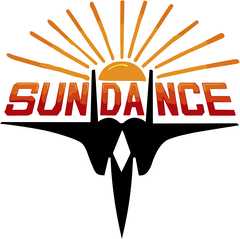 KASPRZYK
KASPRZYK